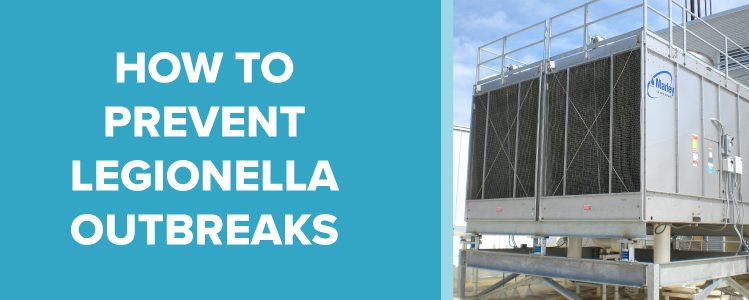
Water safety and quality have been some of the United States’ most pressing concerns in recent years with cities like Flint, Michigan and the Bronx in New York reporting disease as the result of poor water quality. Ensuring the safety and health of your staff and clients is one of the most important things on your mind. Providing safe, disease-free water, however, requires learning more about water-borne, disease-causing bacteria and how to combat them. Of particular concern is the detection of Legionella pneumophila.
Legionella refers to a family of over 50 species of disease-causing aquatic bacteria. Found primarily in freshwater environments across the world, like lakes, streams and man-made water systems, Legionella is largely harmless in natural environments. However, with the use of dark, warm, stagnant human water systems, Legionella has arisen as a prominent disease-causing agent. In these environments, Legionella thrives. Legionella bacteria tend to grow in temperatures ranging from 68 to 122 degrees Fahrenheit, with optimal growth occurring between 95 and 115 degrees, and typically prefer a pH between 5.0 and 8.5, typical conditions for many water systems across the United States.
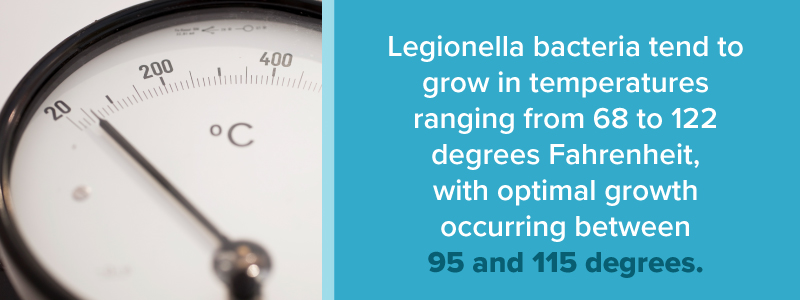
The most deadly species of the Legionella family is Legionella pneumophila, a species name meaning “lung-loving.” This particular variety was the first Legionella species described, discovered following an outbreak at an American Legion convention in Philadelphia in 1976. Later, the species was split into 15 serogroups based on the cell surface antigens of each organism. Only a few of these serogroups are pathogenic. However, the most prevalent serogroup, serogroup 1, is pathogenic in nature. As a whole, L. pneumophila is closely associated with human disease, causing about 70 percent of Legionella infections in Europe.
Legionella poses a serious health risk to people around the world. Any infection of Legionella bacteria is called “legionellosis,” but this infection can result in one of three distinct diseases, distinguishable by their different symptoms. These diseases are:
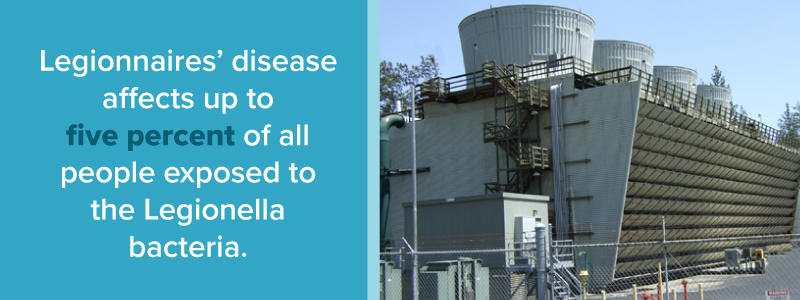
These diseases can be differentiated and diagnosed with a simple blood or urine test. Legionnaires’ disease sufferers may undergo an additional chest x-ray or sputum test to confirm the diagnosis. Sufferers of extrapulmonary infections may need additional tests to confirm the cause of the infection. Immediately after diagnosis, doctors will usually ask the patient questions to determine the possible source of the infection so they can report the outbreak to the proper authorities.
While most healthy people can successfully fight off a Legionella infection after exposure, people belonging to some key demographics tend to be at higher risk for infection and complications. People with the following attributes tend to be more susceptible to a Legionella infection:
Though there is no vaccine for these diseases due to their bacterial nature, they are treatable. If you get Legionnaires’ disease or an extrapulmonary infection, you’ll likely need hospital care and a round or two of antibiotics to get rid of the disease. While this helps reduce the lethality of the infection, complications still occur — among Legionnaires’ sufferers, lung failure is a possibility for people already suffering lung problems, and around one in 10 infected individuals still die from the disease due to complications.
Legionella bacteria spread by aspiration – breathing in the bacteria. Since the bacteria are aquatic, this means a potential victim of the disease has to inhale water droplets containing Legionella bacteria in order to facilitate the infection. This can happen in one of two ways:
Both of these methods of infection require a water source of some kind. In man-made systems, the most common and most concerning infection sites include showers and faucets connected to outdated home plumbing systems, poorly-maintained fountain and hot tub systems and even humidifiers. Even emergency home water stores have been linked to outbreaks, as water containers are often kept in warm, dark environments that are ideal for Legionella growth. However, the most abundant sources of Legionella outbreaks are HVAC cooling towers. The reason for this is discussed in more detail in the next section.
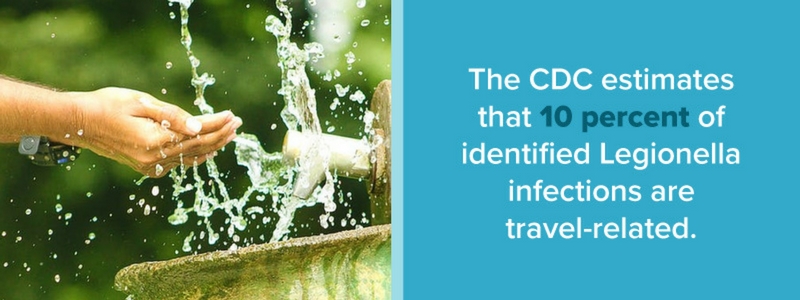
The impact of Legionella on water systems is most apparent in the summer and early fall, when infection rates experience a sharp increase. This is primarily because water systems of all types tend to run slightly warmer during these periods, allowing the bacteria to grow. This season is also ideal for international travelers visiting hotels, resorts and other tourist attractions, many of which use HVAC cooling tower systems. This may why be 10 percent of identified Legionella infections are travel-related, as estimated by the CDC.
This may why the CDC estimates that 10 percent of identified Legionella infections are travel-related.
HVAC cooling towers lead to more infections than any other source, outpacing exposure due to showering by a factor of 100. Exposure through this source is so common due to the fact that HVAC cooling towers combine the perfect growing conditions for Legionella with an air cycling system and tend to be used in buildings containing hundreds of people at a time.
Essentially, HVAC cooling towers are large air conditioning units for commercial and residential buildings, designed to cycle and cool large quantities of air. The system works by cycling air to pass by a refrigeration unit, which efficiently removes heat from the air. These systems also use a recirculated water system, coming in contact with the refrigerant to remove excess heat and dispose of it by way of evaporation. To keep this water from stagnating, the water is cycled through the system by regularly bleeding and adding fluid, discouraging bacterial growth.
Though HVAC cooling tower systems are useful for cooling air, they are also prime locations for Legionella growth. This is due to the following factors:
Most of these factors can be prevented by updating existing systems and keeping up with maintenance. You can also employ a water treatment company like Chardon Laboratories to regularly test your system for pathogenic serotypes of Legionella pneumophilia and develop a customized treatment and prevention plan for your application.
It is common to find Legionella in the raw water entering your water systems, but you can fight off colonization with proper planning and equipment. With the prevalence of potential growth sites — and the appearance of Legionella in city water sources like in Flint, Michigan — preventing Legionella outbreaks is more important than ever before. This can be done with a few basic steps recommended by the World Health Organization:
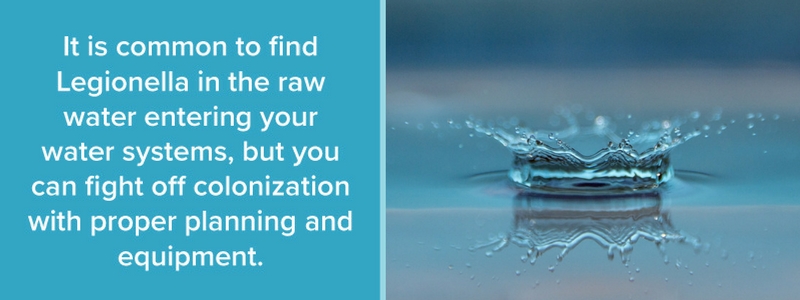
In terms of preventing and controlling Legionella bacteria specifically, facilities can prevent and treat Legionella outbreaks by:
A combination of all these control measures could help control Legionella growth. However, doing so effectively can be a challenge. That’s why you need a team of experienced water treatment professionals on your side.
If you’re looking for an industrial and commercial water treatment company, Chardon Laboratories can offer you great service and results.
Our testing procedures will monitor your systems for harmful Legionella outbreaks, identifying the serogroup of the species and the prevalence of the bacterial growth. If we discover that your systems contain over 100 colony-forming units per milliliter of water, we’ll work with you to develop a customized treatment and prevention program to handle Legionella colonization in your cooling tower systems. Our ISO-certified company works to get you results at competitive and transparent prices. We’ll even provide you with hand-delivered products and regular electronic reports so that you can maintain your system more effectively.
At Chardon Labs, we don’t just sell chemicals — we sell clean systems. Contact us today to learn more about our quality water treatment services.
Page Updated September 26, 2017
Vice President, Water Consultant at Chardon Labs
Matt Welsh is the Vice President and Water Consultant at Chardon Labs. He helps consult a wide range of customers utilizing various methods of water treatment, from chemical to chemical-free approaches, large and small applications, and across a wide range of geographical influences. With 20 years of water treatment experience, including a wide range of troubleshooting and service in potable water and non-potable HVAC and industrial applications, he is an expert in water treatment chemistry for cooling towers, boilers, and closed-loop systems.